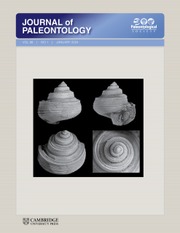Crossref Citations
This article has been cited by the following publications. This list is generated based on data provided by
Crossref.
Zakrevskaya, Maria
2014.
Paleoecological reconstruction of the Ediacaran benthic macroscopic communities of the White Sea (Russia).
Palaeogeography, Palaeoclimatology, Palaeoecology,
Vol. 410,
Issue. ,
p.
27.
Schiffbauer, James D.
and
Xiao, Shuhai
2014.
An Examination of Life History and Behavioral Evolution Across the Ediacaran–Cambrian Transition.
Journal of Paleontology,
Vol. 88,
Issue. 2,
p.
205.
Grazhdankin, Dmitriy
2014.
Patterns of Evolution of the Ediacaran Soft-Bodied Biota.
Journal of Paleontology,
Vol. 88,
Issue. 2,
p.
269.
Orr, Patrick J.
2014.
Late Proterozoic–Early Phanerozoic ‘Taphonomic Windows’: The Environmental and Temporal Distribution of Recurrent Modes of Exceptional Preservation.
The Paleontological Society Papers,
Vol. 20,
Issue. ,
p.
289.
Muscente, A.D.
Marc Michel, F.
Dale, James G.
and
Xiao, Shuhai
2015.
Assessing the veracity of Precambrian ‘sponge’ fossils using in situ nanoscale analytical techniques.
Precambrian Research,
Vol. 263,
Issue. ,
p.
142.
Rahman, Imran A.
Darroch, Simon A. F.
Racicot, Rachel A.
and
Laflamme, Marc
2015.
Suspension feeding in the enigmatic Ediacaran organism
Tribrachidium
demonstrates complexity of Neoproterozoic ecosystems
.
Science Advances,
Vol. 1,
Issue. 10,
Sperling, Erik A.
Knoll, Andrew H.
and
Girguis, Peter R.
2015.
The Ecological Physiology of Earth's Second Oxygen Revolution.
Annual Review of Ecology, Evolution, and Systematics,
Vol. 46,
Issue. 1,
p.
215.
Tarhan, Lidya G.
Droser, Mary L.
and
Gehling, James G.
2015.
Depositional and preservational environments of the Ediacara Member, Rawnsley Quartzite (South Australia): Assessment of paleoenvironmental proxies and the timing of ‘ferruginization’.
Palaeogeography, Palaeoclimatology, Palaeoecology,
Vol. 434,
Issue. ,
p.
4.
Wilby, P.R.
Kenchington, C.G.
and
Wilby, R.L.
2015.
Role of low intensity environmental disturbance in structuring the earliest (Ediacaran) macrobenthic tiered communities.
Palaeogeography, Palaeoclimatology, Palaeoecology,
Vol. 434,
Issue. ,
p.
14.
Droser, Mary L.
and
Gehling, James G.
2015.
The advent of animals: The view from the Ediacaran.
Proceedings of the National Academy of Sciences,
Vol. 112,
Issue. 16,
p.
4865.
Budd, Graham E.
2015.
Early animal evolution and the origins of nervous systems.
Philosophical Transactions of the Royal Society B: Biological Sciences,
Vol. 370,
Issue. 1684,
p.
20150037.
Tarhan, Lidya G.
Droser, Mary L.
Gehling, James G.
and
Dzaugis, Matthew P.
2015.
Taphonomy and morphology of the Ediacara form genus Aspidella.
Precambrian Research,
Vol. 257,
Issue. ,
p.
124.
Vinther, Jakob
and
Smith, Andrew
2015.
The origins of molluscs.
Palaeontology,
Vol. 58,
Issue. 1,
p.
19.
Buatois, Luis A.
and
Mángano, M. Gabriela
2016.
The Trace-Fossil Record of Major Evolutionary Events.
Vol. 39,
Issue. ,
p.
27.
Retallack, Gregory J.
2016.
Field and laboratory tests for recognition of Ediacaran paleosols.
Gondwana Research,
Vol. 36,
Issue. ,
p.
107.
Moczydłowska, Małgorzata
and
Meng, Fanwei
2016.
The Ediacaran
Aspidella
-type impressions in the Jinxian successions of Liaoning Province, northeastern China
.
Lethaia,
Vol. 49,
Issue. 4,
p.
617.
Retallack, Gregory J.
2016.
Ediacaran fossils in thin-section.
Alcheringa: An Australasian Journal of Palaeontology,
Vol. 40,
Issue. 4,
p.
583.
Coutts, Felicity J.
Gehling, James G.
and
García-Bellido, Diego C.
2016.
How diverse were early animal communities? An example from Ediacara Conservation Park, Flinders Ranges, South Australia.
Alcheringa: An Australasian Journal of Palaeontology,
Vol. 40,
Issue. 4,
p.
407.
Cunningham, John A.
Liu, Alexander G.
Bengtson, Stefan
and
Donoghue, Philip C. J.
2017.
The origin of animals: Can molecular clocks and the fossil record be reconciled?.
BioEssays,
Vol. 39,
Issue. 1,
p.
1.
Dohrmann, Martin
and
Wörheide, Gert
2017.
Dating early animal evolution using phylogenomic data.
Scientific Reports,
Vol. 7,
Issue. 1,

